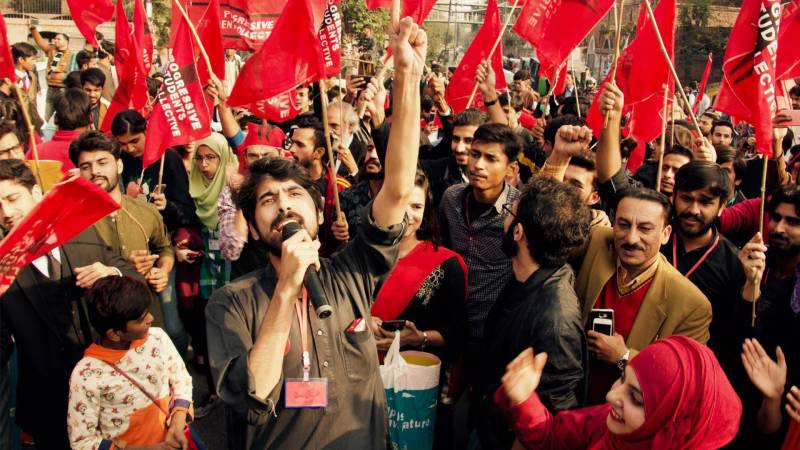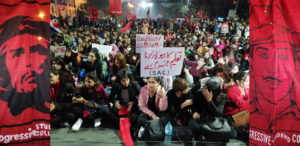
Its 12:00 pm on Monday and I am constantly texting my friends waiting for the government’s stance on closing of educational institutions around the country. While texting back and forth, I scroll through my twitter, #closeallinstitutions is trending on number 1.
My friends ask me what I think would happen. I casually tell them that government will close down the schools and announce online classes after which there will be another twitter trend of #saynotoonline classes. Another friend remarks about MCAT issue and all the delay that has happened this year and how crowded it was last year when the test was taken. I inform her of another twitter trend #delaymcat.
We talk about how social media is used to garner attention on every issue these days no matter how big or small it is especially by students and she says that there should be a proper body to convey the grievances of students to the appropriate institutions. I answer promptly stating that this is exactly why we need student unions. She remarks, "Pakistan does not have student unions”? I stare at her for a second; this is a medical student studying at a prestigious college with all kind of access to social media and internet and yet does not know if there are students unions. I tell her, we don't have student unions and then proceed to inform her about the protest to be taken at press club on the coming Friday November 27 for their restoration.
After our chat, I proceed to ask numerous friends about what they know of student unions. Most of them have little to no knowledge. I am shocked but at the same time I realise there may be thousands of students out there who may be as clueless as my friends and so I decide to compile some basic history of student unions, learning so much about them along compiling the timeline.
As I google ‘student unions and Pakistan’, I learn that the first student union of Pakistan was the All India Muslim Students Federation established in 1937 pre Partition which played an active role in struggle for Independence. Then in 1947 the IJT was established in Lahore followed by numerous student federations set up especially between 1960-70. Many of them were linked with political parties. Some of the prominent ones were;
Democratic Students Federation (established in 1950)
National Students Federation (1953)
Baloch Students Organisation (1967)
Pakhtun Students Federation (1967)
Anjuman-e-Tulaba-e-Islam (1969)
Imamia Students Organisation (1972)
People’s Students Federation (1973 )
All Pakistan Muttahida Students
Organisation (1978)
Insaaf Students Federation (2007)
All of these student federations had their own ideologies; Democratic Students Federation and National Students Federation were prominently leftist, and the IJT and Anjuman-e-Tulaba-e-Islam had an Islamic ideology. Then there were ethnic federations like the Pakhtun Students Federation and All Pakistan Muttahida Students Organisation. In later years, Insaaf Students Federation was founded as a populist federation similar to the Muslim Student Federation.
Over the years, student unions have played immense role in both social and political movements. The 1968 movement which later toppled Ayub Khan’s regime was initiated through student protests. Even Zia ul Haq felt threatened by student power, and resorted to banning student unions in 1984 after progressive and anti-dictatorial alliances swept the union polls of 1983. Benazir Bhutto revived student unions in 1989 for a short period of time before they were banned by the Supreme Court’s 1993 decision; never to see the light of day again. The current ruling party, PTI, mostly relied upon youth in its initial years and even during elections, promising reforms for students but failed to give them any relief after forming government. Last year the Student Action Committee (SAC) asked all student activist groups to come together to hold the student solidarity march for the restoration of student unions. In March 2019, the Progressive Students Collective held protests and demonstrations in 50 major cities across the country and received an overwhelming response. Students from all provinces as well as GB and Azad Kashmir participated in numerous protests along with parents, teachers, doctors and lawyers. The student solidarity march had one purpose: to unite students on one platform to create awareness for issues faced by students. However, the movement was unable to receive the response it desired from the government as numerous students were arrested, and an FIR against the organisers was registered.
Last year the Student Action Committee (SAC) asked all student activist groups to come together to hold the student solidarity march for the restoration of student unions. In March 2019, the Progressive Students Collective held protests and demonstrations in 50 major cities across the country and received an overwhelming response. Students from all provinces as well as GB and Azad Kashmir participated in numerous protests along with parents, teachers, doctors and lawyers. The student solidarity march had one purpose: to unite students on one platform to create awareness for issues faced by students. However, the movement was unable to receive the response it desired from the government as numerous students were arrested, and an FIR against the organisers was registered.
On 4th of November 2019, the Sindh Assembly passed Resolution calling for lifting of ban on student unions. The resolution was passed unanimously and also called for the introduction of a code of conduct to avoid conflict between various student organizations. The Prime Minister of Pakistan Imran Khan pledged to restore student unions in institutions. He reaffirmed that comprehensive policy would be designed for smooth working of the unions.
Till now, no concrete steps have been taken towards the restoration of student unions and after a crisis filled year for students because of the novel COVID-19, the SAC has one again decided to come together on Friday 27 November 2020 to demand a voice in education decision making.
I hope this helps a lot of students to understand student unions and their plight. In the next part, I will be talking about the importance and need for students union.
Notes and references:
History of Student Politics and Its Revival in Pakistan. Punjab University.
Pakistan student unions dilemma (August 9, 2020).Tribune.
My friends ask me what I think would happen. I casually tell them that government will close down the schools and announce online classes after which there will be another twitter trend of #saynotoonline classes. Another friend remarks about MCAT issue and all the delay that has happened this year and how crowded it was last year when the test was taken. I inform her of another twitter trend #delaymcat.
We talk about how social media is used to garner attention on every issue these days no matter how big or small it is especially by students and she says that there should be a proper body to convey the grievances of students to the appropriate institutions. I answer promptly stating that this is exactly why we need student unions. She remarks, "Pakistan does not have student unions”? I stare at her for a second; this is a medical student studying at a prestigious college with all kind of access to social media and internet and yet does not know if there are students unions. I tell her, we don't have student unions and then proceed to inform her about the protest to be taken at press club on the coming Friday November 27 for their restoration.
After our chat, I proceed to ask numerous friends about what they know of student unions. Most of them have little to no knowledge. I am shocked but at the same time I realise there may be thousands of students out there who may be as clueless as my friends and so I decide to compile some basic history of student unions, learning so much about them along compiling the timeline.
As I google ‘student unions and Pakistan’, I learn that the first student union of Pakistan was the All India Muslim Students Federation established in 1937 pre Partition which played an active role in struggle for Independence. Then in 1947 the IJT was established in Lahore followed by numerous student federations set up especially between 1960-70. Many of them were linked with political parties. Some of the prominent ones were;
Democratic Students Federation (established in 1950)
National Students Federation (1953)
Baloch Students Organisation (1967)
Pakhtun Students Federation (1967)
Anjuman-e-Tulaba-e-Islam (1969)
Imamia Students Organisation (1972)
People’s Students Federation (1973 )
All Pakistan Muttahida Students
Organisation (1978)
Insaaf Students Federation (2007)
All of these student federations had their own ideologies; Democratic Students Federation and National Students Federation were prominently leftist, and the IJT and Anjuman-e-Tulaba-e-Islam had an Islamic ideology. Then there were ethnic federations like the Pakhtun Students Federation and All Pakistan Muttahida Students Organisation. In later years, Insaaf Students Federation was founded as a populist federation similar to the Muslim Student Federation.
Over the years, student unions have played immense role in both social and political movements. The 1968 movement which later toppled Ayub Khan’s regime was initiated through student protests. Even Zia ul Haq felt threatened by student power, and resorted to banning student unions in 1984 after progressive and anti-dictatorial alliances swept the union polls of 1983. Benazir Bhutto revived student unions in 1989 for a short period of time before they were banned by the Supreme Court’s 1993 decision; never to see the light of day again. The current ruling party, PTI, mostly relied upon youth in its initial years and even during elections, promising reforms for students but failed to give them any relief after forming government.
 Last year the Student Action Committee (SAC) asked all student activist groups to come together to hold the student solidarity march for the restoration of student unions. In March 2019, the Progressive Students Collective held protests and demonstrations in 50 major cities across the country and received an overwhelming response. Students from all provinces as well as GB and Azad Kashmir participated in numerous protests along with parents, teachers, doctors and lawyers. The student solidarity march had one purpose: to unite students on one platform to create awareness for issues faced by students. However, the movement was unable to receive the response it desired from the government as numerous students were arrested, and an FIR against the organisers was registered.
Last year the Student Action Committee (SAC) asked all student activist groups to come together to hold the student solidarity march for the restoration of student unions. In March 2019, the Progressive Students Collective held protests and demonstrations in 50 major cities across the country and received an overwhelming response. Students from all provinces as well as GB and Azad Kashmir participated in numerous protests along with parents, teachers, doctors and lawyers. The student solidarity march had one purpose: to unite students on one platform to create awareness for issues faced by students. However, the movement was unable to receive the response it desired from the government as numerous students were arrested, and an FIR against the organisers was registered.On 4th of November 2019, the Sindh Assembly passed Resolution calling for lifting of ban on student unions. The resolution was passed unanimously and also called for the introduction of a code of conduct to avoid conflict between various student organizations. The Prime Minister of Pakistan Imran Khan pledged to restore student unions in institutions. He reaffirmed that comprehensive policy would be designed for smooth working of the unions.
Till now, no concrete steps have been taken towards the restoration of student unions and after a crisis filled year for students because of the novel COVID-19, the SAC has one again decided to come together on Friday 27 November 2020 to demand a voice in education decision making.
I hope this helps a lot of students to understand student unions and their plight. In the next part, I will be talking about the importance and need for students union.
Notes and references:
History of Student Politics and Its Revival in Pakistan. Punjab University.
Pakistan student unions dilemma (August 9, 2020).Tribune.
